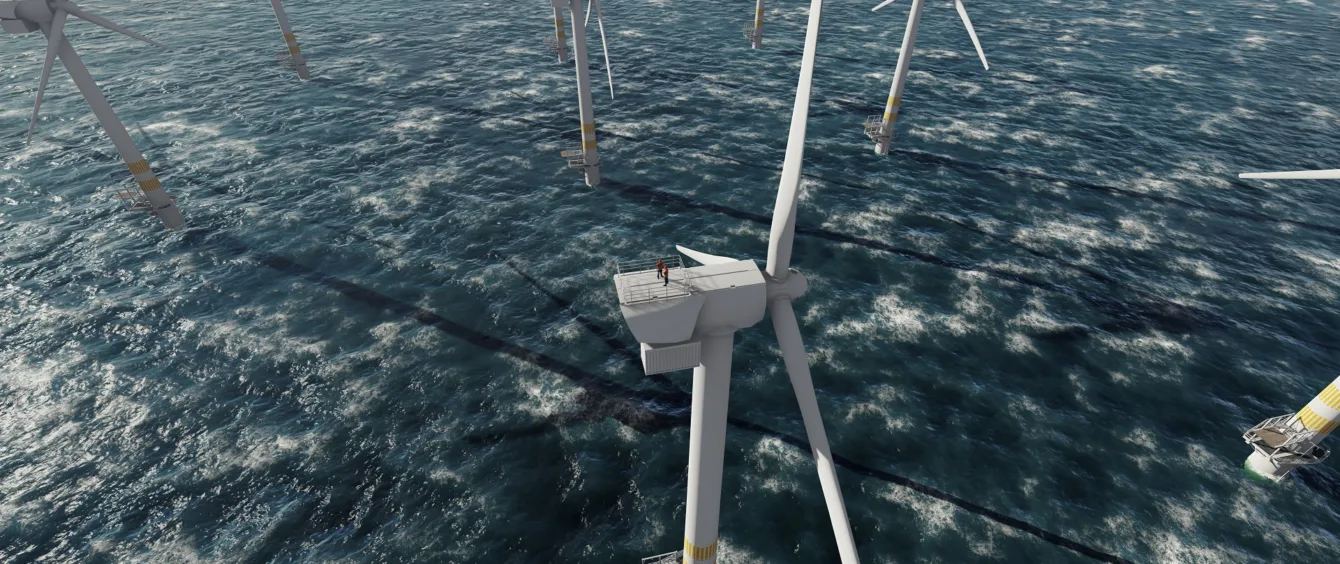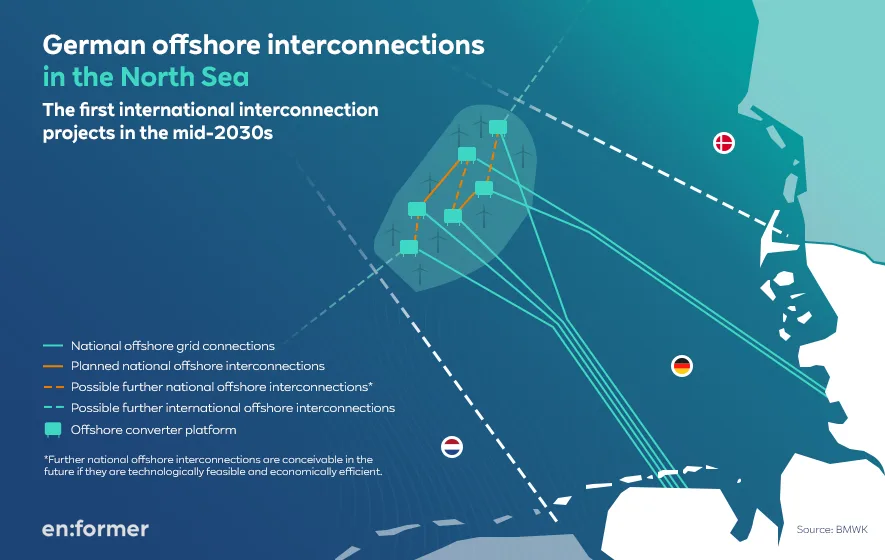Offshore wind is considered a key driver of the energy transition, one reason being that winds at high sea are steadier than those on the mainland. This is why it has long been considered an option to build an international offshore network in the North Sea, thereby increasing security of supply throughout Europe. In Part I of a mini-series, the en:former explores the advantages of offshore wind farms networked with hybrid connectors across borders.
Intentions to create a multinational offshore grid in the North Sea are taking shape. Towards the end of February 2023, three of Germany’s four transmission system operators (TSOs) – Amprion, 50Hertz and TenneT – and the German Ministry for Economic Affairs and Climate Action published plans for the first networking projects in the North Sea (Link in Englisch). This was followed in late April by a conference of countries bordering on the North Sea at the North Sea Summit in Ostend, Belgium, at which an agreement was reached to develop collaborative offshore projects. A European consortium is concurrently working on solutions to overcome the technological challenges of offshore networking.
Offshore network for more efficient power transmission
To date, wind farms at high sea each have a dedicated high-voltage, direct-current (HVDC) transmission line connecting them to the mainland, where the electricity they produce is fed into the transmission system. “We envisage networking several offshore wind farm clusters. In terms of the cost benefit, this is a worthwhile project when it comes to integrating renewable energy into the system, European energy trading, security of supply and grid relief,” says Jan Teuwsen, Head of the Offshore Grid Concepts Department at Amprion. The world’s first offshore interconnector was linked to the grid by 50Hertz and Danish TSO Energinet in October 2020.
North Sea wind farms will be connected to the transmission system in clusters. The wind turbines generate alternate current (AC), which is collected at the wind farms’ transformer platforms. The transformer platforms convert the current at high voltage and transmit it to the transmission system operator’s offshore converter platform where electricity from several wind farm clusters is pooled. The converter platform turns the electricity from an alternate current to a direct current (DC). Future projects can do without the wind farm transformer platform as the electricity will be transmitted from the turbines directly to the converter platform. The direct current will travel along a high voltage line to the onshore grid connection, a process that is considered especially effective when covering long distances due to its fairly low transmission losses.
This is referred to as high-voltage, direct current (HVDC) transmission technology. A further converter station turns the direct current back into alternate current on the mainland so the electricity can be fed into the transmission system.
At the national level, the German TSOs have additional, detailed plans to network offshore wind farms. The 2037/2045 Grid Development Plan (Link in Englisch) published at the end of March 2023 considers offshore networking for the first time while presenting its advantages. For example, connecting two wind farms at sea also requires establishing a new link between the two points to which the electricity flows. The Grid Development Plan describes this as a “flexible bypass to reduce the load on the onshore transmission system.” Teuwsen goes on to say that offshore networking would also increase redundancy: If the first of the two interconnectors fails, electricity from both wind farms could be fed into the grid over the second one.
International wind farm networks for increased power swapping
It is also envisaged that more offshore wind farms be coupled at the international level as well. This would link a country’s wind farms to those of neighbouring nations, enabling them to transmit electricity between various wind farm clusters and between countries. The interconnectors – cross-border powerlines – would thus transmit wind power on the mainland while providing generation capacity for international trade. Owing to this dual function, they are also known as hybrid interconnectors.
Teuwsen explains that since this also couples bidding zones to each other, the system harbours potential to increase electricity trading and, in turn, strengthen competition among providers: “Electricity from a bidding zone with lower prices can be imported to a bidding zone with higher prices.” Furthermore, hybrid interconnectors enhance European security of supply, enabling powerline capacity utilisation to be improved and powerlines to be used more efficiently. In addition, expanding the reach of this technology will bring EU member states closer to fulfilling the requirement of the European Commission imposed on every member state to be capable of transporting 15 percent of its generation capacity to other member states via cross-border powerlines by 2030.
Hybrid interconnectors enable more offshore capacity
The plans announced by the German Ministry for Economic Affairs and Climate Action and the German transmission system operators in late February envisage networking the connectors of offshore wind farms with an aggregate capacity of ten gigawatts. Teuwsen holds that cross-border networking with hybrid connectors to offshore wind farms is desirable especially in view of the ambitious offshore wind expansion goals pursued in Europe: “We need more efficient transmission infrastructure if we want to use the wind power generated in windy areas throughout Europe, and this includes hybrid interconnectors.” The Amprion expert adds that meeting total transmission demand with dedicated interconnectors would require both much more material and land.
This is also the conclusion reached by the authors of a study (Link in German) prepared by the Fraunhofer Institute for System and Innovation Research ISI in collaboration with consultancies Consentec, Guidehouse and r2b energy consulting on commission from the German Ministry for Economic Affairs and Climate Action. The scenario report compares the starting point featuring a single connection to the grid for interconnected offshore wind farms to the European Ten-Year Network Development Plan (TYNDP).
The first comparison scenario includes increased cross-border networking with hybrid offshore wind farm links, whereas the second scenario partially renounces additional offshore wind grid connections in favour of building new electrolysis capacity. The comparison culminates in a recommendation to aim for the first of the two scenarios. This would reduce redispatching needs by 70 percent relative to the status quo. What this means is that conventional power stations would have to be switched on much less frequently to prevent regional electricity shortages that occur when insufficient amounts of green electricity reach their points of consumption.
European plans for a hybrid offshore grid
Based on WindEurope estimates, up to a third of total offshore wind capacity could have a hybrid interconnector by 2050, with the lion’s share being located in the North Sea. The study’s authors believe international cooperation will pose a political challenge. To quote them, “If hybrid offshore wind networking is to make a substantial contribution to the energy transition at the European level, coordination and implementation issues regarding regulation, network and zoning will have to be addressed soon.”
To illustrate this point, Amprion’s Jan Teuwsen gives an example: “When it comes to establishing the details of bidding zones, one needs to address good financeability and responsibility for as well as construction and subsequent operation of the interconnectors.”
This transpired on a grand scale at the Offshore Wind Summit on 19 May 2022, which took place in Esbjerg, Denmark. One-and-a-half years after the aforementioned combined grid solution created by 50Hertz and Energinet, an agreement endorsed by Denmark, Germany, the Netherlands and Belgium was reached. The declared mission is to jointly expand offshore wind capacity to turn the North Sea into Europe’s green power station and to connect the bidding zones to each other for this purpose.
This venture was confirmed in a joint letter of intent at the North Sea Summit in Ostend on 24 April 2023. The transmission system operators of Germany, Denmark, the Netherlands and Belgium proposed specific measures for building a dense offshore grid.
The technical challenges of building a hybrid offshore electricity network and how the players involved are working on solutions will be showcased by the en:former in Part II of the mini-series on plans to create a network in the North Sea.
Photo credit: © dragancfm, shutterstock.com

